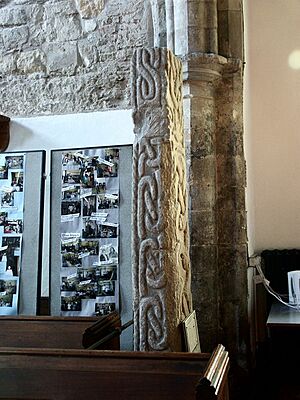Crowle Stone facts for kids
The Crowle Stone is a very old and special stone that used to be part of an Anglo-Saxon cross. You can find it today inside the Church of England parish church of St Oswald in Crowle, a town in Lincolnshire, England.
Discovering the Crowle Stone
The Crowle Stone wasn't always just a stone in a church. It was originally carved as part of a tall cross shaft during the Anglo-Saxon period. Imagine a large, decorated stone cross standing tall!
A Hidden History
For many years, until 1919, this important stone was actually used as a "lintel." A lintel is a strong piece of stone or wood placed horizontally over a door or window opening to support the wall above it. So, the Crowle Stone was holding up part of the church's west door!
It's amazing that this ancient stone survived. It was probably saved because Norman builders, who built the church around 1150, reused it. They needed strong stones for their new church, and this old cross shaft was perfect for their building plans.
Ancient Carvings and Runes
The Crowle Stone is quite large. It stands about 2.1 meters (6 feet 11 inches) tall, is about 40 centimeters (16 inches) thick, and 21.5 centimeters (8.5 inches) wide.
What makes it truly special are the beautiful carvings on three of its sides. Near the bottom of one side, there's a special message carved in "runes." Runes are an ancient alphabet used by people in Northern Europe, including the Anglo-Saxons. This runic inscription helps experts guess that the cross shaft was made before the year 950. After that time, the use of runes almost completely disappeared.


